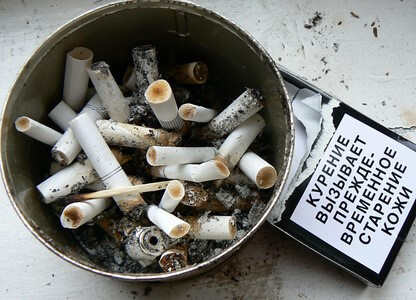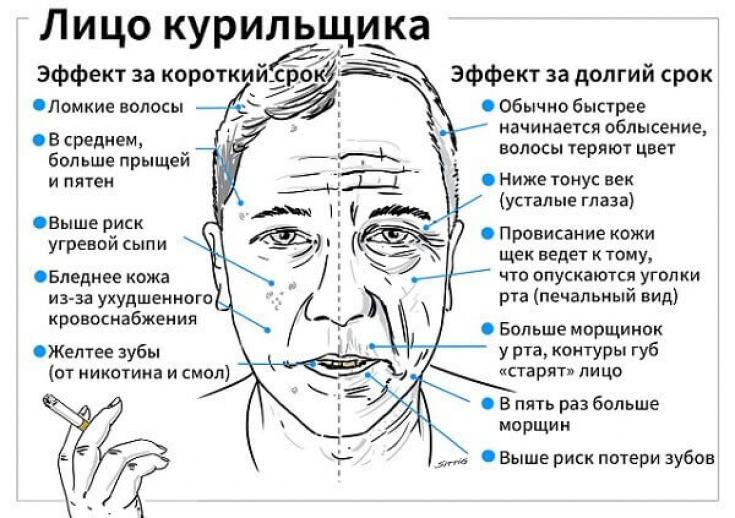Skin and hair are exposed to various environmental hazards, including tobacco smoke.
In addition to the well-known association of smoking with cancer, heart disease, and respiratory disease, smoking is associated with premature skin aging, delayed wound healing, and increased infections, as well as a number of skin conditions, including psoriasis, suppurative hydradenitis and cutaneous lupus erythematosus. There is a general observation that the majority of inflammatory skin diseases occur in smokers.
How smoking damages the skin, read on estet-portal.com in this article.
- Tobacco smoke – evil: the harm of smoking for the skin
- How smoking affects the skin
- How quitting smoking can affect your skinia
Tobacco smoke – evil: the harm of smoking for the skin

Tobacco smoke causes oxidative stress, so insufficient oxygen is delivered to the skin, resulting in tissue ischemia and occlusion of blood vessels.
Subscribe to our page on Instagram!
It reduces host innate and immune responses and induces MMP-1 metalloproteinase, an enzyme that specifically degrades collagen.
Nicotine substitutes are safer for the skin than smoking, although nicotine itself causes vasoconstriction, inhibits inflammation, delays wound healing, and accelerates skin aging.
The influence of the tobacco rack on the genetics of mankind
In the long run, the emaciated skin of a 40-year-old heavy smoker resembles that of non-smoking 70-year-olds:
- wrinkles (e.g. crow's feet, smoker's lines around the lips);
- baggy eyelids and sagging jawline;
- uneven skin coloration: grayish, yellow with pronounced blood vessels;
- dry, rough skin
ss. Thus, the damaging effect of smoking on the skin is undeniable.
How smoking affects the skin
It is not completely clear how exactly smoking causes premature aging of facial skin.
Theories include:Heat from a cigarette burns the skin directly;
- Under the influence of smoking, changes occur in the elastic fibers of the skin (
- elastosis); Narrowing of the blood vessels (vasoconstriction) during smoking reduces the blood supply to the skin and can cause loss of collagen;
- Tobacco reduces vitamin A levels and skin hydration.

, including skin lesions and surgical wounds. This increases the risk of wound infection, tissue death, and blood clots. The reasons for this are unclear, but include:
vasoconstriction and lack of oxygen;- delayed migration of keratinocytes;
- decrease in collagen synthesis;
- stunting of the growth of new blood vessels in the wound.
- Several studies have confirmed that smokers tend to have more extensive and severe psoriasis. The mechanism appears to be that smoking activates inflammatory mediators and promotes keratinocyte proliferation.
There is over a tenfold risk of
chronic lupus erythematosus (especially discoid lupus erythematosus) in smokers compared to non-smokers. Smoking increases autoimmune activity by activating lymphocytes.
What diseases of the oral cavity are caused by smoking Treatment of cutaneous lupus erythematosus with hydroxychloroquine and other drugs is less effective
but in smokers. How quitting smoking can affect your skin
Nicotine-containing patches, gum, lozenges, nasal spray, inhalers, and e-cigarettes may or may not be beneficial for the skin of patients who are trying to quit smoking.
The side effects of these smoking cessation devices can lead to poor patient adherence to treatment.
Nicotine lozenges, gums, and spray can cause soreness in the mouth, throat, and nose, and may also be associated with
acute urticaria.
Bupropionhas been reported to cause:
dry mouth;- itching;
- urticaria;
- angioneurotic edema;
- generalized psoriasis;
- pustular and erythrodermic psoriasis;
- erythema multiforme;
- Stevens-Johnson syndrome;
- Drug hypersensitivity.
- Therefore, both smoking itself and the use of nicotine substitutes harm the skin and the body as a whole. The best solution in this case is to turn on your willpower and
More useful and interesting information on our channel on
YouTube:






Add a comment